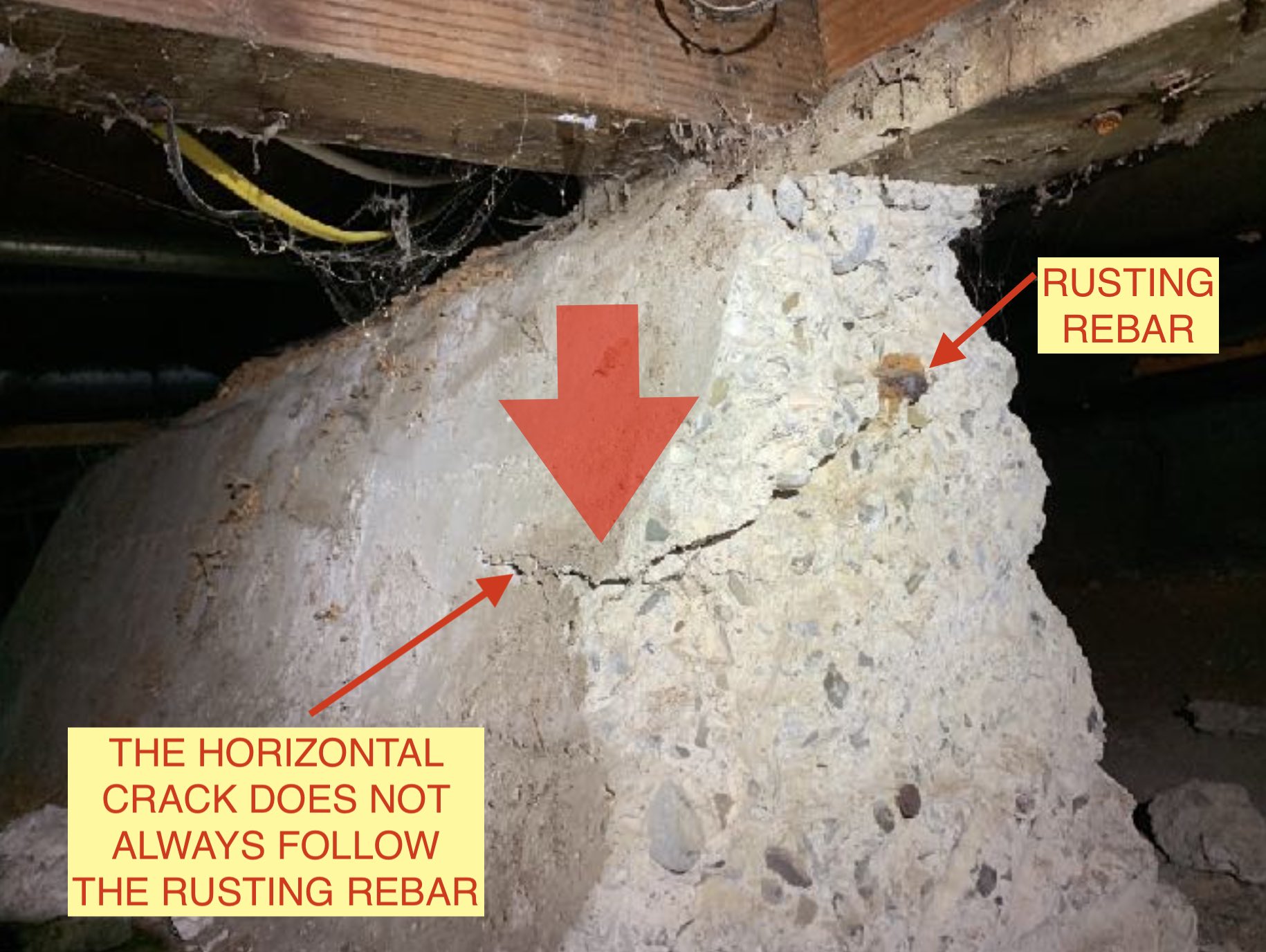|
|
|
|
|
The Definition:
A horizontal crack is a crack in the foundation stemwall seen in the subarea that follows a mostly horizontal line. They are distinguished from vertical cracks (which are usually the result of settlement) or dry shrinkage cracks (which are very thin and harmless). Here is what a typical horizontal crack looks like.
The Problem:
A horizontal crack is a disconnection of the foundation if it goes all the way through (most do). The house is no longer anchored to the earth through the foundation. The house is now predisposed to further damage in a seismic event. It is a structural issue.
|

|
The Cause:
The vast majority of horizontal cracks are caused by rusting of the horizontal rebar in the foundation. The most common causes are (a) insufficient concrete cover (i.e. rebar placed too close to edge of the concrete) or (b) salt from leaking water softener. A less common cause is (c) when neglected vertical cracks allow atmosphere to reach the horizontal rebar.
This photo illustrates that the crack may diverge from the horizontal line of the rusting rebar, though caused by the rusting rebar.
|

|
Avalon's Promise:
The proper repair of horizontal cracks, per the International Concrete Repair Institute (ICRI) and the American Concrete Institute (ACI), is to repair or replace the rebar and replace the damaged concrete. Avalon repairs horizontal cracks in compliance with the ICRI and ACI codes. Additionally, our work on horizontal cracks is always designed and certified by an independent engineer.
|
Horizontal Crack Example:
The rusted rebar is generally hidden inside the horizontal crack. Sometimes the rusting rebar is visible, as shown in this photo. Very likely, the cause was insufficient concrete cover with the rebar placed so close to the edge of the concrete.
Avalon would chip away the concrete to fully expose the rusted rebar and following best practices replace rusted rebar and replace the concrete.
|

|
From ICRI Guideline Number 302.2R-2009 (emphasis added)
Sec.2.1 The practice of completely removing the concrete (undercutting) from around the corroded reinforcement, no matter what degree of corrosion is found, is key to achieving long-term performance of surface repairs. In most cases, complete removal of the concrete from around the reinforcing steel is the best practice, where protection of the reinforcing steel within the repair cavity is achieved by providing a uniform Chemical environment around the reinforcing steel. ...
Sec. 2.4 Concrete removal should extend along the reinforcing steel until there is no further delamination, cracking, or significant corrosion and the reinforcing steel is well bonded to the surrounding concrete. ...
Sec. 2.5 If reinforcing steel has lost cross-sectional area, a structural engineer should be consulted. Repair reinforcing steel by either replacing the damaged/deteriorated steel or placing supplemental reinforcing steel in the affected section. ...
Sec. 2.7 The repair of deteriorated concrete resulting from reinforcing steel corrosion is necessary to extend the service life of the structure. Performing concrete repairs using industry-best practices will ensure the success and longevity of the repair. Understanding the existing conditions and cause of corrosion will assist the engineer in specifying the type and extent of the repair required ...
|

|
Avalon Structural, Inc.
181 Ridgeview Drive
Aptos, CA 95003
(831) 479-4389 (office)
info@avalonstructural.com |
Copyright © 2020
Avalon Structural, Inc.
All Rights Reserved
|
CA License 677116
Classifications: B, C-8
Avalon is a general building
contracting firm and
does not employ engineers. |
|
|
|
|